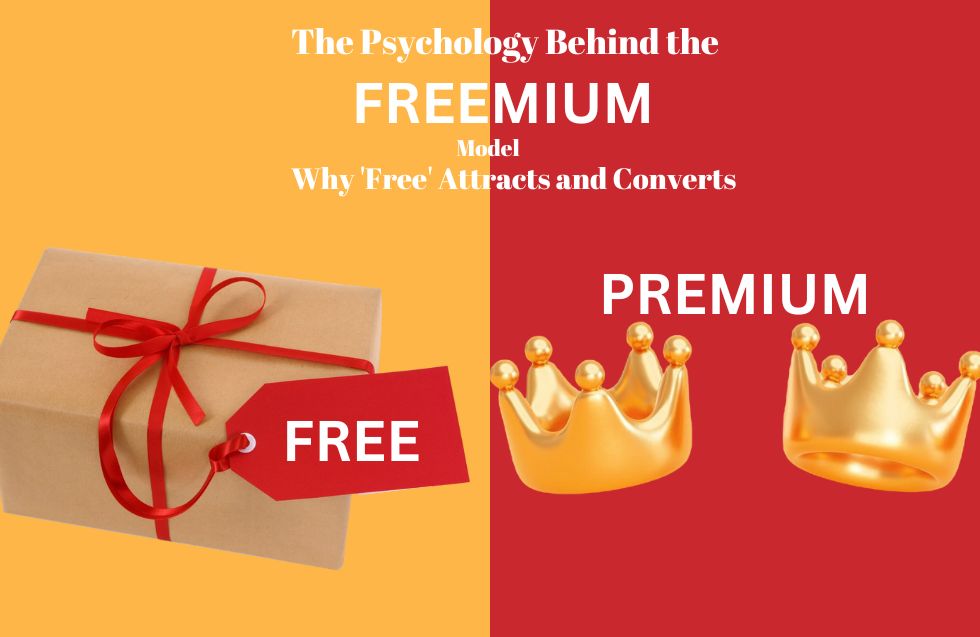In today’s digital economy, the “freemium” business model has become a dominant strategy for customer acquisition and retention. By offering a free version of a product with the option to upgrade to a paid tier, companies can attract a large user base and drive revenue through premium features, services, or subscriptions. But what makes the freemium model so effective? At its core, the success of freemium hinges on psychological principles that leverage consumers’ attraction to “free” offerings, lower perceived risks, and foster emotional engagement. In this article, we’ll explore the psychology that underpins the freemium model and examine case studies of companies that have successfully converted free users into paying customers.
The Allure of “Free”
One of the most powerful aspects of the freemium model is the psychological pull of “free.” Research shows that people are wired to seek out free products and services due to the immediate reward they represent and the perceived lack of risk involved. The concept of “free” taps into the brain’s reward system, triggering a positive response and creating an attractive offer that feels hard to resist. According to a study by behavioral economist Dan Ariely, people are more likely to choose a free product over an alternative, even if the latter has better value, because the perceived loss in a free choice is zero. This “zero-risk bias” makes people more inclined to take the first step and try a product without any upfront financial commitment.
In the context of freemium, offering a free version removes the barriers to entry and appeals to a broad audience, particularly users who are curious but may not yet be convinced of the product’s value. By reducing this initial friction, companies increase the likelihood of user sign-ups and can build a large, engaged base from which a portion can be converted into paying customers.
The Principle of Reciprocity
The freemium model also taps into the principle of reciprocity, a psychological phenomenon where people feel compelled to return a favor when they receive something for free. In the freemium context, users are initially given access to a free product or service, creating a sense of goodwill and appreciation. As they continue to use and benefit from the product, they may feel a sense of obligation to give back, often by upgrading to the premium version or purchasing additional features.
This principle plays a significant role in conversion rates, as satisfied users who recognize the value they’re receiving from the free product are more likely to invest in the premium offering. The freemium model builds a long-term relationship where users gradually see the product’s value and decide to contribute financially.
Case Study 1: Spotify – From Free Music Streaming to Premium Subscriptions
Spotify is one of the most successful companies leveraging the freemium model. When the music streaming service launched, it offered users free, ad-supported access to millions of songs. However, Spotify also provides an optional premium subscription with benefits like offline listening, ad-free streaming, and higher-quality audio. This approach attracted millions of users worldwide, who initially used the free service.
Spotify’s freemium model plays on the concept of “loss aversion,” which refers to people’s tendency to avoid losses rather than seek equivalent gains. By allowing users to experience high-quality music streaming for free, Spotify helps users become accustomed to its value. When users try the premium features through free trials, they are more likely to feel the loss of quality and convenience when reverting to the free tier, which nudges them toward subscribing to maintain the enhanced experience.
The results have been impressive: in 2022, Spotify reported 489 million monthly active users, of which 205 million were premium subscribers. By building a loyal base of free users and gradually converting them, Spotify has created a successful freemium model that continues to drive its growth.
Creating Value Through Premium Features
To effectively convert users, freemium businesses must create a clear distinction between the free and premium versions. Premium features should provide noticeable value, making the paid tier appealing and worth the cost. A successful freemium model is designed to entice users with a robust free experience, but it should also offer meaningful improvements that make the premium version highly desirable.
For instance, cloud storage services like Dropbox and Google Drive use freemium by offering limited free storage. For users who need additional space, file-sharing capabilities, or other advanced options, the premium subscription becomes essential. This model works particularly well for businesses that aim to target both individual users and larger enterprises, as it allows basic users to meet their needs while appealing to professionals or power users who require more comprehensive services.
Case Study 2: LinkedIn – Leveraging Professional Networks with LinkedIn Premium
LinkedIn, the professional networking site, has effectively harnessed the freemium model by offering free basic accounts and optional premium subscriptions. LinkedIn Premium provides features such as InMail messaging, detailed analytics on profile views, and enhanced search filters that help professionals and recruiters find the right connections.
The psychology behind LinkedIn’s freemium model is rooted in self-enhancement. By offering analytics and insights as part of LinkedIn Premium, the platform appeals to users’ desire to improve their professional visibility and connect with the right people. LinkedIn users who want to increase their chances of landing jobs or making industry connections are more likely to invest in Premium because it helps them achieve these goals.
LinkedIn’s strategy has been effective in attracting paying customers. According to LinkedIn’s parent company, Microsoft, LinkedIn reached 950 million members in 2023, with a growing percentage of users opting for premium accounts due to the networking and job search advantages it offers. LinkedIn’s model showcases how providing exclusive tools and insights that align with user aspirations can motivate them to pay for added value.
The Freemium Model and Habituation
Another psychological concept that underpins the freemium model’s success is habituation, the process by which users become accustomed to a product or service and incorporate it into their daily routines. As users spend time with a free version, they develop habits around its use, which can make the idea of upgrading less daunting. When people integrate a product into their workflow or daily life, they are more likely to consider upgrading if the premium features improve that routine.
Productivity apps like Trello, Slack, and Evernote leverage this approach. Trello, a project management tool, offers basic functionality for free but includes additional features such as larger file uploads, enhanced automation, and team collaboration tools for paid accounts. As users become accustomed to organizing their tasks on Trello, they often find that the premium features align with their growing needs, prompting them to upgrade.
Case Study 3: Zoom – Expanding Communication Capabilities through Freemium
Zoom, the video conferencing platform, rose to prominence due to its user-friendly freemium model. During the COVID-19 pandemic, when remote communication became essential, Zoom offered free video calls with a 40-minute limit on group meetings. The time restriction didn’t affect one-on-one calls, making Zoom an ideal choice for casual users while encouraging businesses to invest in the paid version to remove the limit for team meetings.
The freemium model allowed Zoom to become a staple for both personal and professional use, driving a massive user base. By providing core functionality for free, Zoom gained significant visibility and allowed users to incorporate the platform into their routines. The limitations of the free plan, such as the 40-minute time cap, created a soft pressure to upgrade, particularly for businesses and educational institutions that required longer meeting times.
Zoom’s strategy paid off: by mid-2020, the company saw a 30-fold increase in daily meeting participants, reaching 300 million users. Zoom’s freemium model successfully converted free users into paying customers by offering essential functionality while reserving advanced features for premium users.
Designing for Conversion: Strategies for Freemium Success
For businesses considering a freemium model, there are key strategies to optimize conversion rates:
- Define Clear Value for Premium: The premium features must offer compelling value to justify the cost. Companies should identify and segment features that provide substantial benefits and focus on marketing these distinctions.
- Optimize Free-to-Paid Conversion Paths: Many freemium businesses utilize in-app prompts, upgrade options, and targeted offers to gently nudge free users toward upgrading. Freemium apps like Canva, a graphic design tool, frequently showcase premium templates and features, offering users a preview of what the premium version provides.
- Use Data to Guide Improvements: Successful freemium businesses rely on data analysis to understand how users interact with the free and premium versions. Tracking key metrics, such as daily active users, conversion rates, and retention, can help companies refine their approach and increase paid conversion rates.
- Create Urgency or Exclusivity: Offering time-sensitive deals, premium trials, or limited-time access to premium features can prompt users to upgrade sooner. This approach can be particularly effective when combined with in-app messaging or personalized email marketing.
Conclusion: The Freemium Model as a Gateway to Growth
The freemium business model continues to thrive due to its ability to attract large audiences by offering free value while leveraging psychological triggers that encourage paid upgrades. The appeal of “free,” the sense of reciprocity, and the gradual integration of a product into users’ daily lives create a powerful foundation for conversion. Through carefully designed premium features and an understanding of user behavior, businesses can transform their free offerings into profitable customer relationships, as demonstrated by companies like Spotify, LinkedIn, and Zoom. For companies willing to explore the freemium model, understanding these psychological principles can unlock significant growth and create a path to long-term success.












